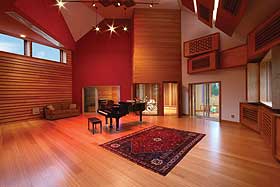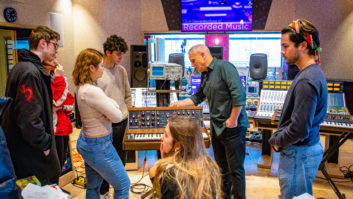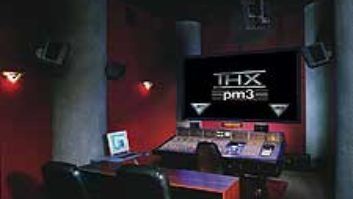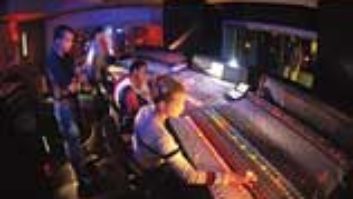
The tracking room can hold a big band or a small orchestra as there’s a lot of chamber music in the area.
Photo: George Roos

From row, from left: contractor Dave Ross, owner Dave Snyder, Coral Sound’s Matt Marinelli and Tech Mecca’s John Klett. Back from, from left: Guilford Sound staffer Bill Esses, studio designer Francis Manzella and FM Design architect Bill Seegmuller.
Photo: Jeff Woodward

Numerous RPG acoustical treatments were used throughout, including this room.
Photo: George Roos
Guilford Sound, Dave Snyder’s new studio in southern Vermont, is at once a blast from the past and the wave of the future. On the one hand, it’s the kind of facility almost no one builds anymore—ground up, big tracking and control rooms, multiple iso rooms and even an echo chamber in the attic—but it’s also among the most environmtentally friendly studios Mix has featured, and its complement of acoustical finishes and equipment blends the best of old and new.
Snyder is the former owner of mix room Jarvis Studio (Susan Tedeschi, Los Lobos, Hal Wilner) in New York City. When he and his wife, Sarah, decided to move their young family to 300 wooded acres in Vermont, their plan included building a studio as well as their new home. It’s a lucky man who can afford to build his dream facility in an idyllic location, and to have Francis Manzella of FM Design help create it.
“I’d heard a bunch of mastering rooms [that Manzella designed for, including] Sterling Sound—also Stratosphere [Sound, New York City]—and I just loved the treatments he did,” recalls Snyder, who says that one of the main things he wanted from the new design is “a lot of space. I was in a band called Ruth Ruth, and we worked in a bunch of places that had cramped control rooms. I was really excited to be able to build from the ground up—to have a large enough control room for people to be able to hang out in the back of the room and not be on top of each other.”
INSIDE THE CONTROL ROOM
The control room Manzella designed is 27 feet deep and 24 feet across at its widest point. It’s an ergonomic setup where Snyder can roll easily between the API Legacy console that came home with him from Jarvis, his Pro Tools HD rig (with 48 channels of Mytek conversion) and the custom racks of outboard gear located behind him (Pultec EQP1As, Neve 32264s, Neve Melbourne Sidecar with Flying Faders, a rack of original Neve 1073s rebuilt by Matt Marinelli of Coral Sound and more). And there’s still plenty of room for musicians and producers to hang out in back.
Adjacent to the control room is a machine room that houses—among other things—two Studer A827 tape machines. “They have virtually no hours,” Snyder says. “Somebody bought them at a studio right at the end of the analog Golden Age, and they just sat there. Matt Marinelli rebuilt the power supplies so they’re as good as new.”
Technical consultant John Klett and Marinelli created all of the wiring/infrastructure within the facility—the unglamorous, but crucial, part of studio design: “I’ve been working with Coral Sound as my go-to for prefabricating complex wiring and interconnect systems since the mid-’90s,” Klett says. “On this project, I did specify some different wire for certain parts that we normally use. We use enormous amounts of Mogami cable. No one stocks enough to fill our orders these days. But we’re also looking at other products all the time. We use Gepco cable for specific things, and after testing, listening and comparing, I decided to go with their X-Band multipair mic cable for the fixed-in-place mic tielines. This facility is physically large and some of the cable runs are quite long so I wanted to look at and review steps we could take to reduce potential loss in the mic runs—there is no lossless cable.
“On this project, as with many,” Klett continues, “I provided overall guidance and specified equipment and specific aspects for the power conditioning/isolation, technical Earth systems, power and technical isolated ground distribution. There are little details about this that you have to pay attention to, especially within large systems. No matter how awesome the gear and wiring are, it all rests on the power and ground systems. Digital studios don’t escape this—the problems just manifest differently. Guilford is a hybrid, having both extensive analog and large digital workstation components.”
VARIED ACOUSTICS
“On the performance side of things,” Snyder says, “I really wanted to have a room that could accommodate a big band or a small orchestra. There’s a lot of chamber music in this area; the Marlboro Music Festival [Marlboro, Vt.] is a well-known chamber music festival that has been around for 50-plus years, and it brings a lot of notable musicians from that world to the area. I knew I wanted to pursue those clients, so we built our studio to be big enough to accommodate those groups comfortably, but there’s [still] plenty of isolation for us to work with amplified music.”
Manzella approached the recording rooms with the idea of providing varied acoustics to enhance different types of instruments. The main recording room features a live side/dead side design, and the iso rooms offer a variety of sonic environments: “All of the iso booths are fairly unique in their acoustics,” Manzella explains. “There’s a very dead, smaller-sized booth adjacent to the control room, which is a great vocal booth; and there are three other rooms that open off of the main room, and you’ve got good sightlines between them all, as well as sliding doors or windows to the live room. There’s a very diffuse room. There’s what we would call a medium room with a slate floor—there’s wood flooring in most of the bigger rooms—and another booth that has a tighter sound with a carpeted floor, and another dead-to-medium room. You can also vary the sound by close- or far-miking, opening or closing the sliders; there’s all sorts of possible variations.”
As he often does, Manzella made use of numerous RPG acoustical treatments in these rooms, as well as “a very large, maybe the largest, custom diffuser at the rear of the control room,” he says, “which is great because you get diffusion down to much lower frequencies, and in the diffuse iso booth, we did a custom overhead wooden skyline diffuser.”
Recently, Snyder hosted engineer Lawson White and the So Percussion group, recording a piece written for them by composer Steve Mackie, and after the sessions, Snyder sent Manzella this e-mail message: “[We had] marimba in the live room, drums in Iso 3, percussion in Iso 4, steel drums and vibes in Iso 2. Steve, a veteran studio patron who attended the session, said he’s never heard the low end of marimbas sound so huge and so tight as it sounded in your live room through your amazing [Griffin] speakers…It was fun to watch the giddy reaction to all of the amazing sonics created.”
GREEN DESIGN, GREENPOWER
An equal source of pride for Snyder is the green footprint of his studio. All of the wood used for the project construction, furniture and interiors was milled from trees cleared on the studio site. The studio also uses three alternative energy sources: solar power via roof panels, ground-source heat pumps for HVAC and a wood-fire boiler system (also fed by firewood from the property) that heats the Snyders’ home and studio. “It’s got very low emissions,” Snyder explains. “You pack it full of wood and there’s a fan that blows everything down into this catalytic converter chamber that then injects it with a second input of oxygen, and it combusts everything. It burns 90 percent of the particulate, so when you look at the chimney, it’s just vapor coming out.”
Also representing the studio’s commitment to green building is its extensive use of LED lighting and natural light: Almost every room has windows to the beautiful wilderness that surrounds the studio. “We’re very close to civilization,” Snyder says, “but when you’re up here, you feel like you’re in the middle of paradise. We’re 10 minutes from a town [Brattleboro, Vt.], from 24-hour stores, only two hours from Boston, three-and-a-half hours from New York, but you get that retreat aspect—like you’re in the middle of nowhere.”
Images From the SO Percussion Recording Session
Photos: Sasithon Poorviriyaku

Adam Sliwinski of SO Percussion

Jason Treuting of SO Percussion

Josh Quillen of SO Percussion

Lawson White recording SO Percussion




